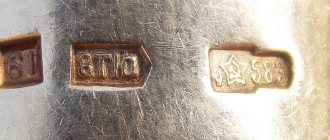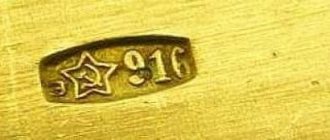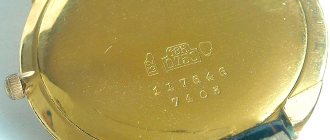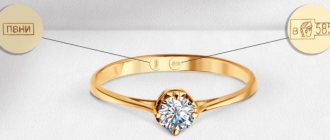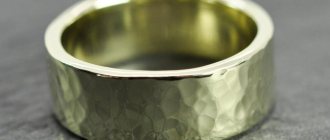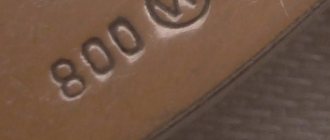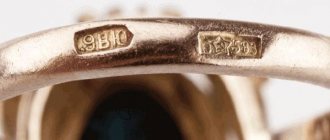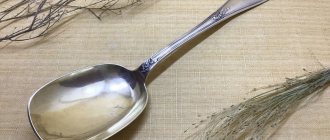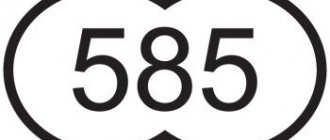The branding method was introduced in the Russian Empire by Peter the Great. The system for determining the purity of alloys made it possible to move the jewelry industry to a new level, tightening control over all precious products that were in use. Over time, it had to be abandoned, but the alloys with excellent characteristics that were produced in those days are highly valued today. The 56th standard gold stands out especially. It can be converted to the metric system, but modern metal with this designation has a different type of ligatures.
Sample 56 gold of Tsarist Russia: the spool system and the history of the appearance of markings
Peter the Great initiated the introduction of the spool system on the territory of then Tsarist Russia. Problems in the jewelry industry that arose earlier:
- coins of different weights and sizes were issued;
- difficulties arose in determining their value;
- Determining product characteristics has become more difficult.
The introduction of a unified system for assessing the quality of precious metals made it possible to solve all problems. The product was stamped according to the spool system, as well as the jeweler’s initials.
For the evaluation of gold jewelry, the system began to operate in 1711.
Gold ring 56 standard
It is based on a unit of measurement, which was the spool relative to the pound. Pure gold (without additives) corresponded to 96 spools. This is what 1 pound contains. Knowing this, the proportion of impurities is calculated. If there are 56 pure gold, the rest (40) are additives. The system existed until 1927.
Types of gold samples
In the old days, the spool test was placed on trinkets so that buyers could distinguish the original from the fake. This system got its name because it contained 96 units (ninety-sixth of a pound - this is the spool). Over time, this sampling system was changed. From 1927 to the present day, the metric system is widespread and familiar to many. The most common and well-known types of markings include the following:
- The yellow metal without impurities is marked 999.9; in the old days it corresponded to the number 99.
- Products with the numbers 375 at that time corresponded to the mark 36.
- Jewelry with the number 500 was marked 40.
- Rings and earrings with a small addition of other metals are marked 585. In the old days this designation was 56.
- Modern 750 standard on jewelry was previously designated by the number 72.
Pure gold is rarely used for making jewelry or other items, because they will be very soft, which will lead to deformation of the product, as well as weigh a lot and be very expensive. The alloy with the 900 mark is used for minting coins, and in its pure form aurum can only be seen in ingots. Prices for gold coins and bars on the market depend on the prices of precious metals on the world market.
Sample composition, characteristic properties
The content of additional components allows you to improve the characteristics of the metal. But they are different. If you find an antique bracelet, chain or ring with 56 carat gold among your belongings, you need to find out what it is before taking any measures.
The product is gold, but differs in composition from modern analogues with the same amount of precious metal. If you convert the sample from the spool system to the metric one, it turns out that this is the gold standard of Tsarist Russia and the Russian Federation - 585.
Typically, silver was used to change the properties of the gold alloy. Other additives were also used:
- platinum;
- palladium;
- copper;
- nickel;
- tin;
- brass.
Gold earrings with mark 56
Density
Today, spool test 56 corresponds to metric 585, which allows you to navigate by the density of modern metal. The average value of the parameter is in the range of 12.5-14 / cm3. It is more difficult to determine the density of the metal more precisely, since the type of alloys in the composition is different.
As a result, products containing the same proportion of gold differ in density due to different ratios of additives.
Fusibility
The metal is deservedly called the gold standard. This means that it is endowed with excellent properties and is characterized by high fusibility. This feature makes it possible to produce jewelry and other jewelry of complex shapes. Fusibility is increased due to the additives included in the composition.
Strength
The characteristics of the metal improve as the proportion of gold decreases. This means that 56 sample is the best option: the material contains a large amount of precious metal, but at the same time it is durable and can withstand high mechanical loads.
Gold ring with 56 hallmarks
Inertia
The gold alloy was previously considered unaffected by harsh chemicals. Now it is called conditionally inert. This may mean that the precious metal most often does not react with chemicals.
But upon contact with some of them, the gold alloy may lose its properties or completely dissolve.
Range of shades and their alloys
If a metal is designated in a standard way - it has a 56 mark stamped on it, this does not mean that it can only have 1 color. Below are different combinations of ligatures, but the amount of gold is the same - 58.5%:
Convert carats to grams
The karat measurement of metals should not be confused with the designation of precious stones.
There the values change, for example, 513 carats corresponds to a stone weighing 102.6 grams, 583 carats - 116.6 grams, 686 carats - 137.2 grams. The metric system determines the value of an alloy based on the gold content of 1 kg of the alloy. The most popular standard is 585, which means that per 1000 grams of alloy there are 585 grams of gold and 415 grams of impurities and other metals.
Since different countries have different systems, sometimes buyers get confused in determining the value of a product when choosing jewelry abroad. Gold hallmarks indicated in carats can be easily translated into understandable Russian numbers: 9 carats means a hallmark of 375 gold, 14 carats means 585, and 24 carats corresponds to the purest gold of 999 purity. For the manufacture of rings, 565 and 575 samples are most often used.
Stamps designate not only products made of gold, but also those made of silver and gilded. For example, a pure silver bar is 999 fine, but this composition is not suitable for making jewelry due to its softness and other physical properties. Household items correspond to hallmark 875, and jewelry - to 925. But gold rings, earrings and chains are not marked with hallmarks 593 and 725. Most likely, you got a fake, and you can determine this fact by contacting a pawnshop or buyers. They will evaluate the product.
Stamp on products before and after 1897
The end of the 19th century was also marked by a transition from the old branding method to a new one. Until 1897, convex tests were applied to products made of jewelry alloys. Moreover, their size depended on the dimensions of the product. This means that the brand could sometimes create discomfort when worn. Soon the branding method was changed. The sample was not noticeable. It was flush with the metal. Today, a stamp is also used.
Types of stamps on gold items
The stamp of those times depicted a woman’s head in a kokoshnik. But already in 1927, another option began to be used. It depicted the head of a worker with a hammer. All types of marks are found on antique products. However, if the external signs of 56-carat gold are studied, you will notice that the designation on it was different even then. There is a stamp with letters. This may indicate the jeweler's initials. There is another option - applying the initials of the manager of the assay district.
Tips for choosing gold jewelry
Purchasing a gold item is a serious procedure. You need to analyze prices and quality in different jewelry stores, checking first of all the following:
- grinding quality;
- uniformity of the surface of the product;
- absence of defects: cracks, depressions, abrasions, dents, breaks, scratches;
- quality of decoration.
In addition, you should pay attention to the tag - a kind of passport of the jewelry. It must be formatted correctly and contain the following information: manufacturer, name;
- company address or contact details;
- the name of the product itself;
- type of metal and its purity;
- weight;
- price.
Expert opinion
Lyudmila Pestereva
Our most experienced gold investor
Ask a Question
Tags that do not have this information are not considered a passport of the product and indicate poor quality of the jewelry, possible counterfeiting and cheapness.
The value of 56 samples in the metric and carat systems
After the change in the form of government in the country, another system for assessing the quality of precious metals was introduced - metric. The principle of determining the gold content in a composition is based on calculating the proportion of precious metal in 1000 g of alloy. Accordingly, sample 585 (which corresponds to 56 spool) is a numerical designation of the weight of the main precious metal (585 g) relative to 1000 parts by weight. The amount of additives in this case will be 415 g. Sample 56 when transferred to other systems:
| Zolotnikovaya | Metric | Carat |
| 56 | 585 | 14 |
Types and forms of brands
Precious jewelry is marked not only with gold hallmark numbers. All products must be branded. The applied mark may have a different shape, depending on the country of origin and the designation system adopted there. In Russia, two types of printing are most often found:
- image of a female profile facing the right side;
- a hammer and sickle located on a five-pointed star.
Regardless of the shape and type, the mark must contain mandatory information: the code of the service that applied the seal, the marking of the content of precious metal in the alloy used and the symbol of the assay service’s identification.
The cost of products is directly proportional to the percentage of precious metal. It is almost impossible for a simple buyer who has no experience working with jewelry to determine the authenticity of the applied mark. Often very good and high-quality fakes with 585 or even 750 purity are passed off as real gold. In fact, scammers have learned to illegally apply samples and deceive consumers. To check whether the value of the mark corresponds to the true content of the precious metal, a visual inspection with magnifying devices and additional testing procedures will be required.
The surface of the gold object is first cleaned, then passed over the surface of a special stone. There should be gold stripes left on it, onto which you need to apply reagents. If the sample is high, then the remaining strokes will not disappear and will not even change color. If the strips have completely dissolved, it means that the product is of low quality or does not contain yellow metal at all. At home, it is extremely difficult to determine the quality of products , and it is not even always clear whether it is gold or silver. The 325th standard is the lowest that is allowed in jewelry production; it may outwardly look like a gold-plated silver product.
325 gold items are in demand and highly valued in England and some other countries. In Russia, this metal is considered low-grade. Separately, we can highlight jewelry with the designation 588. They are made of a high-quality alloy, including 11 parts of yellow metal and 1 part of elite platinum. The cost of such goods is much higher. Elite items also include items marked 983; their price can be extremely high due to the use of noble red gold.
How many carats are in this sample?
The spool system was used in Tsarist Russia, while the metric system was used in the Soviet Union. In the West, the carat system is used to measure fineness.
| Spool value | Metric value | Carat value |
| 56 | 585 | 14 |
Alloy Application
Gold of this type was used to make jewelry and various types of jewelry. Most often, the 56 sample can be found on rings and rings, but it was also used to create earrings, chains, bracelets, crosses, pendants and other products. Today it is used more often than others for making wedding rings.
In the Soviet Union, such a test was used in almost all gold products, marking them with the 585 stamp.
Interestingly, until 1914, this gold alloy was used, among other things, to make Olympic medals and sports cups.
Question-answer section
56 gold standard corresponds to what standard?
Expert opinion
Pribrezhny Gennady Valentinovich
Jeweler 6th category
Jewelry alloy can be converted into any of the existing systems for assessing metal purity. If we take the metric as a basis, then 56-carat gold will correspond to only 1 option - 585. In the karat system there is also an analogue with the same properties and degree of purity - 14K.
Gold purity 56 on the ring and the letters - what does this mean?
Expert opinion
Grishanov Mikhail Petrovich
Jeweler, director of the Grishanov and Co. workshop
It matters what numbers the sample contains. The numerical option is now popular. It consists of only numbers. But sometimes among old things you find an item with a mark that also contains letters. This may mean the initials of the jeweler, the manager of the assay district. Today, too, on products made of precious alloy you can find 2 marks, instead of one. Among them there is a name sign, signifying belonging to a jewelry house or manufacturer.
Gold wedding ring
The first sample of gold in Russia
In Russia, the sample designation was introduced much later than in other European countries. Branding of the precious metal on the territory of the Russian state began only in 1700 during the reign of Peter I. During his reign, coins were 98% pure gold and had only 2% copper. To check the authenticity of the coins, they were tested by teeth, since gold is a very soft metal.
To this day, the tradition of biting the award has been preserved among athletes, letting everyone know that a gold medal has been won. Although now they are not actually made from pure metal, but are only coated with a small layer of gold.
Pros and cons of an ancient stamp
56-carat gold is highly valued. But not everyone has any idea how expensive jewelry from the times of Tsarist Russia is.
Alloy advantages:
high value: the composition includes gold, silver, and sometimes platinum group metals, which increases the price of products;
the ability to obtain different shades while maintaining the original volume of the base precious metal;
high resistance to mechanical damage;
plasticity allows you to create jewelry with complex configurations.
The material with the designation 56 also has disadvantages:
a large number of additives, which does not allow the metal to be classified as high-grade;
vintage design - not suitable for everyone;
high price, but in tsarist Russia the metal was more accessible to the solvent part of the population.
Advantages and disadvantages
56 (585) is considered a more valuable alloy than 583, which is most popular in jewelry stores today. But in terms of gold content, 56 is inferior to most samples on the precious metals market. Despite this drawback, it remains popular with us due to certain advantages:
- hardness and wear resistance;
- wide range of colors;
- increased strength and durability;
- plasticity, which allows you to create unique jewelry.
The alloy acquires these properties due to the content of various impurities in it: zinc, copper, palladium, silver, nickel, platinum. The amount of additives does not spoil the overall quality of gold, but only allows you to control its properties.
Where and how can you buy 56-carat gold?
The metal, whose composition corresponds to 585 standard, is obsolete. This means that the purchase and sale transaction is carried out at different prices. Today, metal products 56 are much more expensive than jewelry produced in the Russian Federation.
People who do not understand the issue are ready to sell jewelry as scrap. But at the same time you can lose profit, because... the rate is disproportionately low compared to the real cost. Other possibilities should be considered.
Pawnshop and antique dealer
If you need to buy or sell gold from Tsarist Russia, it is better to first visit a pawnshop or contact a trusted antique dealer whose appraisal you can trust. It is proposed to consider other options: Internet resources, advertisements, purchasing. In this case the cost will be lower. If jewelry is sold via the Internet (Avito website and similar ones) or advertisements, the price is set independently.
Where can I buy and sell such a sample?
Original 56 mark jewelry can only be purchased from antique dealers. But its metric analogue is available in almost any jewelry store. It was used more often in the Soviet Union, but even today this alloy is found quite often in various products. Jewelry marked 56 hallmark can only be purchased in antique stores, from private individuals or in pawn shops.
Pawnshop and antique dealer
The cost of products with the mark 56 is very high, as they have historical value. The most inexpensive will be wedding rings from pawn shops, inherited ones. But it is difficult to find such specimens.
The minimum price per gram of this alloy in antique shops and pawn shops is 2,000 rubles.
The price increases several times if the product contains precious stones, and the cost will be even higher if there is a jeweler’s mark. Some 56-carat jewelry has a seven-figure price tag.
Where is the metric analogue sold - 585 standard
Jewelry made in the Russian Federation is tested. On the product you can see the mark 585. This is an analogue of the gold of Tsarist Russia only in terms of the content of the main precious metal. Otherwise, jewelry represents a separate category. Accordingly, you can purchase them in jewelry stores.
Sample 585 gold
Varieties of silver
Even in ancient times, it was noted that not only its quality, but also its appearance depended on the composition of the silver alloy. This is how various types of alloys appeared, as well as different methods of processing finished products, which are very popular in the production of silver products.
Blackened silver
In Ancient Rus', even before the advent of our era, they discovered a method of blackening silver, when products were covered with beautiful black patterns. By mixing silver, copper, lead and sulfur in certain proportions, the so-called niello was obtained. After engraving the silver item, it was heated until the niello was completely dissolved and turned black. The result was an interesting combination of dark and light shades.
Liquor set made of blackened 875 silver. USSR, Northern Chern. 1966
At first, blackened silver was used mainly to create amulets and elixirs, but with the heyday of blackening in the 17th century, engravings, cigarette cases, dishes and other products began to appear, which were considered very fashionable to have. A special feature of blackened silver is its strength. Products made from it do not need cleaning.
Oxidized silver
The combination of silver with sulfur also leads to darkening of the noble metal, but this combination has its own characteristics. While blackened silver is a strong compound, the same cannot be said about oxidized silver. The darkening effect here is created using a special film, which is easily damaged during the cleaning process. Therefore, you need to carefully inspect the product when purchasing, so as not to buy oxidized silver instead of blackened silver.
It is worth noting that both methods of processing silver have their own jewelry value. In particular, oxidation allows you to play with shades of black and even purple, giving the product not only the effect of antiquity and nobility, but also making it more colorful. After polishing, the convex parts of the oxidized silver product become shiny, and the concave parts become dark.
Ring made of oxidized silver. Convex and concave areas have different shades.
Typically, oxidized silver is used to create small-sized jewelry. These can be handmade earrings, chains or bracelets, as well as products in need of restoration. Since blackened and oxidized silver are practically the same in price, the buyer decides for himself which material to choose.
Matte silver
Matte silver has a noble appearance and is resistant to tarnishing. The natural shine of silver is removed using special equipment such as a sandblaster, as well as by etching in certain solutions.
Silver egg-purse. Enamel on filigree. Russian empire. 1908-1917
Gilt silver
Spraying silver with a thin layer of gold gives the silver item not only a luxurious appearance, but also increases its chemical resistance. Gold-plated silver cutlery is suitable for salty and acidic environments where regular silver would react chemically.
Gilded milk jug. 950 standard silver. France. End of the 19th century
There are other varieties of silver obtained using different techniques and substances.
Cost of 1 gram of pure gold
The price of precious items varies, which depends on the exchange rate of precious metals established by the Central Bank. You can find out what the average cost of gold of the highest standard is from the table:
| 999 standard on the Central Bank/per 1 gram, rub. | Market price, rub. | Scrap, rub. | Jewelry stores, rub. |
| 4250 | 2267 | 2040 | 4069 |
Considering that antique metal is considered a rarity and is valued by antique dealers using completely different parameters, its value is calculated differently. The Central Bank exchange rate is not used in the calculations, but it is necessary to determine the price for 1 gram of Russian gold, hallmarked according to the metric system (585).
Sample systems: metric, carat, spool
The numerical designation of the sample is applied to all jewelry, but not all jewelry is marked according to a single system. Today, two sample systems are used - metric and carat, but in the last century in Russia the spool system was used.
Metric
Used in most countries of the world. The highest standard of the system is 1000th. For example, a 750 gold alloy contains 75% gold, the remaining 25% comes from other metals.
It is difficult to achieve the exact content of precious metal in an alloy, so GOST sets a remedium of 3 units for alloys containing gold, silver, and copper. That is, a gold alloy of 375 purity of gold should contain from 372 to 378 units (a deviation of 3 units in both directions is allowed). If the material contains nickel, then the remedium is 5 units. For an alloy of 585 standard, only a positive remedium of 5 units applies - deviations are allowed upward, but not downward.
Carat
Currently used in some European countries and the USA. The highest standard of the system is 24. Samples of 9, 14, 18, 22 are used - they show the content of pure precious metal in the composition. For example, 18 karat gold means that 18 of 24 parts are pure gold (this corresponds to 750 fine gold in the metric system). 1 carat in this system is equal to 9.744 grams.
Zolotnikovaya
Spool samples are old gold samples; they are no longer used. This system was used in Russia until 1927. The highest standard is 96. The units of measurement are:
- 1 pood = 40 pounds = 16.380 kilograms.
- 1 pound = 96 spools = 409.512 grams.
- 1 spool = 4.266 grams = 96 shares.
- 1 share = 0.044 grams.
For marking jewelry, samples of 56, 72, 92, 94 were used. If a sample of 56 was indicated, this meant that 1 pound (96 spools) of such an alloy contained 56 spools of pure gold (this corresponds to 585 samples of the metric system).
Table of the relationship between the spool system and the modern metric system
| Zolotnikovaya | Metric |
| 36 | 375 |
| 48 | 500 |
| 56 | 585 |
| 72 | 750 |
| 92 | 958 |
| 96 | 999 |
The spool testing system was used in Russia from the founding of the Assay Supervision Inspectorate in 1798 until 1927.
It is very difficult to determine more precisely the age of the jewelry that bears the 56th standard. If, in addition to the hallmark, there is a manufacturer's name on the jewelry, then you can look for a specialist among antique dealers who will try to determine the year of manufacture of your jewelry. You can read more about this in the article How to determine the age of jewelry.
Sources
- https://goldsovet.ru/skupka-zolota-56-proby
- https://ToZoloto.ru/proba/56-proba-zolota.html
- https://VseoMetallah.ru/zoloto/proba/proba-56-na-zolote
- https://bank25.ru/zoloto-56/
- https://zhazhdazolota.ru/proby/56
- https://zolotogid.ru/metally/sistema-oboznacheniya-proby-na-zolotyh-izdeliyah-i-pozolote/
- https://vplate.ru/zoloto/chto-oznachaet-56-proba/
- https://grandfor.ru/uslugi/zoloto-56-proby/
- https://russam.ru/stati/o_juvelirnyh_izdelijah/p18881-kakie_byvajut_proby_zolota/
- https://prozoloto.com/uvelir/skolko-stoit-56-proba-zolota/
Recommendations for caring for antique gold
Vintage items must be cared for with care, be it a ring, earring, chain or other jewelry. Basic recommendations:
- to maintain shine, regularly clean the products with a lint-free cloth soaked in a soap solution, but this should be done not once a year, but if necessary, preferably more often, in order to avoid the formation of a greasy coating as it wears;
- You cannot use abrasive agents, and the ban applies not only to stones, but also to precious metals;
- It is recommended to purchase a special paste - you can find it in jewelry stores.
Minting coins from scarlet gold
The minting of red gold coins was carried out according to the general principle of issuing similar banknotes - on special machines. The main overlay was a blank with an imprint of applied images and symbols, but they were all arranged in the reverse order.
The device forcefully embosses a given pattern and other parameters on the material, forming a complex relief.
In total, there are two minting methods: a minimum of technology, but more manual labor and vice versa. The first case is often used for the release of limited, anniversary batches. The second is a great way to “multiply” money in millions of copies.
Among other distinctive features, during production they form a edging with a small protrusion above the main part, and also make numerous marks on the sides. This approach significantly reduces the number of high-quality fakes.
Reviews
I have a lot of old jewelry left from my relatives - from my grandmothers, cousins (the family is large, my relatives were wealthy in those days). I thought that no one needed such jewelry anymore. I tidied it up, cleaned it, took photos of each item and decided to put it up for sale. One buyer called me, introduced himself as a collector, and took everything at a good price.
Maria G., Mirny
Maria K., Murmansk
56-carat gold became the discovery of the year for me when I was going through our things in the attic. I found several rings from that time. They look modest, dark yellow in color. I wanted to throw it away, but the presence of a sample, albeit such a strange one, stopped me. I took it to the jeweler, he said it was gold and recommended where I could donate it.
When I was selling an old ring from an antique dealer, another client was looking through a catalog of antique jewelry in front of me. I don’t know why anyone would buy something like this; on the contrary, I wanted to get rid of mine. But he told me that he was collecting his collection, making investments in this simple way.
Svetlana D., Donetsk
Russian coins indicating weight and fineness in spools
In the Russian system of weights and measures there was a unit with the alluring name “zolotnik”. It is inextricably linked with numismatics, since the weight of gold and silver was not only measured in spools, but also minted on coins of the Russian Empire (and even the USSR). In addition, the purity of the metal in the spool sample system was calculated in fractions. Therefore, numismatists interested in royal coins should take a closer look at the spool.
Spool like a coin
Philologists trace the origin of the word “zolotnik” to gold coins that came to Ancient Rus' from Byzantium. If you listen closely, the words “solid” (the name of the Byzantine coin) and “gold” (the Russian name for the metal from which it is made) seem very similar in sound. However, in those days the metal was often called a little shorter - “gold”. For the first time, the word “zolotniki” in relation to gold coins was recorded in the agreement between the Kyiv Prince Oleg and Byzantium, dated 911.
Zlatnik of Kievan Rus
From this word came the name of the first coin of Ancient Rus' made of gold, which historians call “zlatnik” or “zolotnik”. With a diameter of 19 to 24 mm, the weight of known specimens varies from 4 to 4.4 grams, averaging 4.2 grams (the weight of the Byzantine solidus in those days was about four and a half grams). The design of the zlatnik (or zolotnik) also copies the “bezant” or “bizantine”, as the Byzantine solidus was called in Europe. On the front side there is a portrait of the ruler (this is evidenced by the inscriptions “VLADIMIR ON THE TABLE” or “VLADIMIR AND HIS GOLD”). The prince is also indicated by the family sign of the Rurikovichs, similar to a trident (located above Vladimir’s shoulder). On the back is the face of God. Christ appears with the Gospel pressed to his chest. So that there is no doubt, the design is complemented by the arc inscription “JESUS CHRIST”. Zlatnik is a cast, not minted coin. The researchers noted both very noticeable casting defects and the elaboration of the elements of the mold design, which was quite complex for that time.
100 rubles 1988 (gold)
Together with the silver coin (serebrenik), the zolotnik became the fundamental basis of the coinage of our country. The small number of coins, however, did not have much economic significance, since this money, most likely, was not intended for settlements. They were probably given a political role. The presence of coins made of precious metals declared that Kievan Rus did not lag behind Byzantium, which it looked up to. In tribute to the zlatnik, the State Bank of the USSR placed his image on one of the coins included in the large-scale series “1000th Anniversary of Russia”.
Spool as a measure of weight
Although the spool was not widely used as a coin, it remained in use as a measure of weight. The Russian spool was equal to 4.266 grams and was used for weighing rare and valuable objects and precious metals, as evidenced by the proverb “The spool is small, but the gold weighs; The camel is big, but it carries water.” Another proverb - “Small is the spool, but dear” - is tied to the issue of gold coins that appeared during the monetary reforms of Peter the Great. Let's try to figure out how true this is.
2 rubles 1718 (gold)
There were no silver Peter's rubles yet, but gold single and double chervonets with the Tsar's profile on the obverse were already minted. They were made using high-grade gold (969 standard). A single chervonets weighed 3.47 grams (pure metal 3.36 grams). The double chervonets had a total mass of 6.94 grams (6.72 grams of pure metal). As you can see, the weight of these coins is very far from the above indicated value of the spool. This fact is not surprising, since the chervonets were intended for settlements with other countries, and not for internal circulation. Most likely, the golden two-ruble notes put into circulation under Peter I in 1718 are compared to the spool in the proverb. Their weight of 4.1 grams is already close to the value of the spool. However, it is necessary to add that their gold standard is 781, so there was only 3.2 grams of pure metal in such a two-ruble note. In numismatic articles regarding the results of the monetary reforms of Elena Glinskaya (1535) and Peter I (the junction of the 17th and 18th centuries), it is often presented that Russia was the first to switch to the basis of a decimal accounting system in the monetary sphere. But the spool as a unit of weight measurement was not based on the decimal system. It was divided into 96 shares and represented a third of the lot, which in turn was equivalent to 1⁄32 pounds.
Spool sampling system
When talking about the lot, we must remember that it was he who was the basis of the lot system of samples, on which measurements of metal purity were based in Western Europe. For example, in this system the number of lots of precious metal in one grade of alloy was taken into account. In 1711, Russia introduced a spool standard for silver. For gold it would be approved much later - in 1733, already under Anna Ioannovna.
In the sampling system, the unit was a spool consisting of 96 shares, in which the content of pure metal and the content of alloy were expressed. If no explanation was given for the number, then it meant pure gold or silver. The number “96” denoted a metal with an exceptionally small amount of impurities, and the sample could not be higher. The most commonly used samples in this system were the 92nd, 72nd and 56th samples. For example, the 72nd sample meant that out of 96 shares, 72 shares were allocated to pure metal, and 24 shares to the ligature. Accordingly, the alloy was designated “72-spool silver” or “72-spool gold.” The metal in two gold rubles corresponded to the 781st standard in the metric system or the 75th in the spool system. It is very simple to convert the value of the spool system of hallmarks to metric: you need to multiply the value of the fractions by 125 and divide by 12. For gold jewelry, an alloy was used that had a hallmark of at least 36.
10 rubles 1755
Let's see how the weight in spools and the spool test system intersected in official documents of that time. For example, let’s take the Personal Decree of Elizabeth Petrovna “On the Making of Gold Coins, Imperials, Half-Imperials and Red Coins”:
“So that Our current and gold coins are also established in good order for the benefit of commerce, and the far-reaching reach of Our glory and splendor, and not only against Our silver coins, but also against foreign coins of the same kind, have a correct proportion, and can be created with multiplication, for which they most graciously indicated.
- From now on, make gold imperials and half-imperials at the price of ten and five rubles,
eighty-eighth standard , ten ruble coin or imperial, each weighing
three spools and eighty-five ninety-sixths of a spool
, five-ruble or half-imperial, each weighing a
spool and ninety-ninety-sixths of a spool
, according to the image below in this description with the price assigned to them, for which coins throughout Our Empire will go at the prices assigned to them without adding or decreasing it. - Made from 1701 to 1754 in red coins, to go among the people and accept all kinds of payments, for each identical red note there are two rubles of twenty-five kopecks, and a double one is twice as much.
- The gold two-ruble coins made from September 1718, 1730 to the 26th, with the image of the Apostle St. Andrew, first called with a cross, are no longer in circulation among the people, and where there are such coins in our treasuries, they are no longer released to the people, but send to Our mints, where there will be more capacity nearby, for redistribution into the above-mentioned imperials and half-imperials..."
Here we are faced with the 88th spool test. When converting it to metric (88*125/12), we get the number “916.66666...”, that is, the 917th sample, which is indicated in the catalogs. Products made of precious metals had different characteristics than coins, therefore the 94th, 92nd, 82nd and 72nd samples were considered standard for gold products. The 56th standard occupied a special place, because after the transition to the metric system, it gave rise to the 583rd standard, which became the most popular for Soviet gold jewelry. The standards for silver were the 95th, 91st, 88th and 84th samples of the spool system.
Silver ruble of Paul I
The hallmark in the spool system began to be indicated in 1798 on rubles from the reign of Paul I in the form of a raised inscription on the edge “EIGHTY THIRDERS WITH ONE THIRD STAMP.” At the same time, the edge on other denominations in silver remains cord-like. On the edge of rubles of Alexander I of mass coinage, this inscription remained until 1810 (newly made copies are known with a depressed inscription on the edge of a different content from later issues).
Coins of the Russian Empire with the designation of weight in spools
Silver ruble of Alexander I
Since 1810, the St. Petersburg Mint, which had recently completed the transition to new equipment, once again changed the design of all-Russian coins. For large silver, the reverse indicated the weight of pure metal in spools and shares of “PURE SILVER 4 GOLD. 21 SHARE." The fineness of the alloy and the total weight of the coin are now indicated by a pressed inscription on the edge “SER. 83 1/3 SAMPLES 4 AGL. 82 14/25 SHARES.” Let's try to calculate the total weight in the usual grams. 14/25 is 0.56. Now let's convert the fraction to a decimal fraction: 82.56 / 96 = 0.86. In spools the total weight is 4.86, and in grams 4.86 * 4.266 = 20.73276. Let's look at the catalog and find a value of 20.73 grams.
Silver half of Alexander I
If the metal standard for half coins remained the same, then their weight was half as much, therefore the inscription on the reverse changed - “PURE SILVER 2 GOLD = 10 1/2 HALES.” At the edge, the total weight is also different - “SER. 83 1/3 SAMPLES 2 AGL. 41 7/25 DOL.” Having gone through the algorithm for converting samples into the metric system, we get the 868th sample of metal.
The rarest test coin of Nicholas I
Half-fifty coins of this type were not issued under Alexander I. They could have appeared under Nicholas I, but only a sample from 1827 with the inscription on the back “PURE SILVER 1 GOLD” remains for history. 5 1/4 SHARES”, which became one of the most expensive coins of the Russian Empire. Instead, analogues were put into circulation, in which the reverse indicated not the weight, but the denomination - 25 kopecks.
Gold coin of Alexander I
Gold coins acquired an indication of weight on the reverse even under Alexander I. Since 1817, five-ruble coins began to be minted with a new type of design (“eagle with lowered wings”). The center of the reverse has the inscription “PURE GOLD 1 GOLD = 39 LOVES.”. The edge, unlike silver rubles and poltinas, does not contain information about weight and purity and is decorated with a sequence of inclined dotted lines.
Platinum coin of Nicholas I
In 1828-1845. The St. Petersburg Mint minted a line of platinum, which included denominations of 3, 6 and 12 rubles. Almost pure metal with a small proportion of impurities was used for minting, so the numerical indication of the sample was unnecessary, and the total weight differed only slightly from the weight of platinum. We will give the mass of each coin below in spools (as indicated by the inscription on the reverse) and grams:
- 3 rubles - “2 ZOL• 41 DOL• PURE URAL PLATINUM” – 10.36 grams;
- 6 rubles - “4 ZOL• 82 DOL• PURE URAL PLATINUM” – 20.71 grams;
- 12 rubles - “9 ZOL• 68 DOL• PURE URAL PLATINUM” – 41.41 grams.
Gold 3 rubles
Since 1869, the three-ruble denomination has been assigned to gold coins, which complement the minting of five-ruble coins. The weight of the precious metal here turned out beautifully, without fractions - “PURE GOLD 81 PARTS”, which corresponds to 3.6 grams. The metal breakdown remains the 917th, already familiar to us from Elizabethan coins.
Gold coin of Alexander II
In 1885, a regulatory document “Rules on the Coin System” appeared. Starting next year, the gold standard will be lowered to 900. The minting of three-ruble notes ceases, and a gold ten is added to the five. The portrait of the autocrat returns to the obverse, and the State Emblem moves to the reverse. But the weight of the pure metal remains on the coin, only now it is indicated on the edge along with the sign of the mintsmeister: “PURE GOLD 1 GOLD 34.68 SHARES (A•G)” for 5 rubles and “PURE GOLD 2 GOLD 69.36 SHARES (A• D)" for 10 rubles. Since 1886, the standard of silver in 25 and 50 kopecks, as well as rubles, has been increased to 900. The ruble coin acquires the inscription on the edge “PURE SILVER 4 ZOLOTNIK 21 SHARES (A•G)”, which appeared instead of half a 50 kopecks - “PURE SILVER 2 ZOLOTNIK 10.5 SHARES (A•G)”, and 25 kopecks instead of the dotted edge – “ PURE SILVER 1 GOLD 5.25 PARTS (A•G).”
Gold coin of Nicholas II
During the Witte reform, Russia switched to the gold standard with a simultaneous decrease in the gold content of the ruble. In 1897, a new line of coins appeared with the same hallmark, but a different weight. On their edge, along with the initials of the mintzmeister, the weight of the precious metal is also indicated:
- 15 rubles - “PURE GOLD 2 GOLD 69.36 HALES” - 11.61 grams;
- 10 rubles - “PURE GOLD 1 ZOLOTNIK 78.24 SHARE” - 7.74 grams;
- 7 rubles 50 kopecks - “PURE GOLD 1 ZOLOTNIK 34.68 SHARE” - 5.8 grams.
The exception was the five-ruble coin, where the edge is filled with a pattern of lines, among which is the sign of the mintzmeister. The weight of pure silver in spools under Nicholas II continues to be indicated by the edge inscription on 50 kopecks and the ruble. A corrugated edge receives 25 kopecks, and their production is soon phased out. In this form, the weight of pure metal, measured by spools, is maintained until the collapse of the Russian Empire. At the turn of the century, the “Regulations on Weights and Measures of 1899” was published, where 1 spool was officially equated to 1/96 of a pound, which is approximately 4.26575417 grams.
Indication of weight in spools on Soviet coins
Silver ruble 1922
The first coins with the symbols of the RSFSR, minted in 1921, were made according to tsarist standards. Not only the diameter and mass values have been preserved, but also the silver standard, as well as an indication of the weight of pure metal in the spools. It was minted in Slavic script on rubles (“PURE SILVER 4 ZOLOTNIK 21 SHARE”) and 50 kopecks (“PURE SILVER 2 ZOLOTNIK 10.5 SHARE”) in 1921 and 1922. along with the sign of the mintzmeister. The weight in spools is also indicated on the edge of the 1923 gold chervonets, with parameters similar to the Tsar’s ten-ruble notes.
Silver fifty dollars 1924
In 1924, the first rubles and fifty dollars of the USSR were issued. At that time, the metric system of measures was already in full use, which was legalized by the decree of the Council of People's Commissars of the USSR of July 21, 1925. The edge inscription represents the transition period from the spool system to the metric one. The main designation of weight is already indicated in grams, but in brackets it is also given in spools. Therefore, on fifty kopecks the inscription (if you omit the mintsmeister sign) looks like this: “PURE SILVER 9 GRAMS (2 Z. 10.5 D.),” and on rubles – “PURE SILVER 18 GRAMS (4 Z. 21 D.).” Since 1925, weight per edge has been indicated only in grams. Regarding the spool system of samples, we can say that the transition from it to the metric one occurred after 1927.
Golden chervonets 1982
And yet, the weight in spools happened to once again appear on the coins of the USSR. From 1975 to 1982, the State Bank of the USSR massively minted replicas of gold chervonets of the RSFSR, leaving the previous design with the exception of the date and replacing the sign of the mintsmeister with the designation of the yard. Therefore, we can say that the last Russian coins using the designation of weight in spools were issued in 1982. These chervonets are still in circulation, as the Bank of Russia assigned them the status of an investment coin.
Authenticity of silver products
There are quite a lot of fake silver items on the market, which may have “branded” hallmarks (hallmarks). The great demand for such products is due to the fact that many buyers have no idea what a sample should actually look like. They already consider the presence of such a sample to be sufficient reason to believe in the authenticity of the product. At the same time, for counterfeiters, stamping is not a particularly big problem. But a professional will always be able to distinguish a fake brand from a real one.
Fake samples
To determine the authenticity of a particular mark, you need to at least know the specifics of the forgery process itself. Fake products are often made of soft metals, so the marks have softer contours.
When determining the authenticity of a hallmark on an antique silver product, it is necessary to take into account the specifics of production. Fraudsters often do not take into account that this or that sample was used only in specific years of production, and was also placed in certain places of branding. For example, in Russia, silver was stamped with an image of a woman’s head in a kokoshnik, a digital hallmark and the letter of the state inspectorate. At first, the woman's face was turned to the left, but since 1908 it has been turned in the opposite direction. Also, in different years, product marks were placed in different places.
Sample with the image of a woman in a kokoshnik (turned to the left). The product was produced in the period 1899-1908.
Sample with the image of a woman in a kokoshnik (turned to the right). The product was produced at the end of the 19th century. – early 20th century
In addition, different countries have their own standards, which also need to be taken into account when working with the sample. For example, English silver hallmarks have their own characteristics compared to French or Russian hallmarks.
One of the common techniques used by counterfeit manufacturers is to transfer the original mark from one item to another. In particular, it can be taken from a spoon and soldered to an expensive antique silver item. Professionals skillfully hide the soldering area under the engraving. And yet, upon closer examination, traces of soldering can be detected, especially if you breathe on this place.
Upon careful examination of the product under a magnifying glass, you can also notice a difference in the wear of the stamp and the product itself, which also indicates a fake.
At the same time, high-quality fakes can only be identified by professionals using special equipment. It allows you to detect both an alloy composition that is uncharacteristic for a particular production period and a lack of protection. Information about the degrees of protection is contained in the technical documentation for the mark and is under state protection.
How to determine the authenticity of silver
The authenticity of a silver item should be determined by an expert, especially if we are talking about antiques. However, at home you can always conduct simple experiments that will allow you to suspect a fake.
If a silver product is magnetic, then this is a fake, since silver never magnetizes. At the same time, the absence of interaction with a magnet does not prove its authenticity, since some metals and alloys are also not magnetic.
The presence of another metal under the silver can also be a clear sign of a fake. It is enough to make a scratch with a sharp object to find out.
If the product does not become hot when placed in hot water for a few seconds, it means it contains metals with low thermal conductivity. Silver heats up instantly, as it has high thermal conductivity.
If a silver item gets your hands dirty, it contains a lot of zinc. In such cases, cunning sellers like to come up with various excuses, for example, that the person whose hands were dirty with a silver amulet is damaged.
It is worth taking a closer look at the quality of the product itself. For example, if we are talking about a silver chain, then every detail of a branded item is carefully worked out. At the same time, a fake usually contains small elements of low quality or enlarged to simplify production. On counterfeit products, the locks may not close properly, and individual elements may have uneven edges or irregular shapes. It is also possible for the links to break, their length and shape to vary.
The peculiarity of home methods for determining the authenticity of a silver product is that they cannot be called reliable. With their help, you can only suspect a fake, but you cannot prove the originality of the product, so it is always better to seek help from experts.

